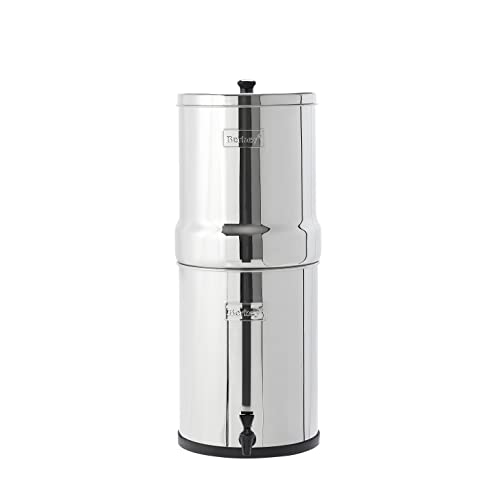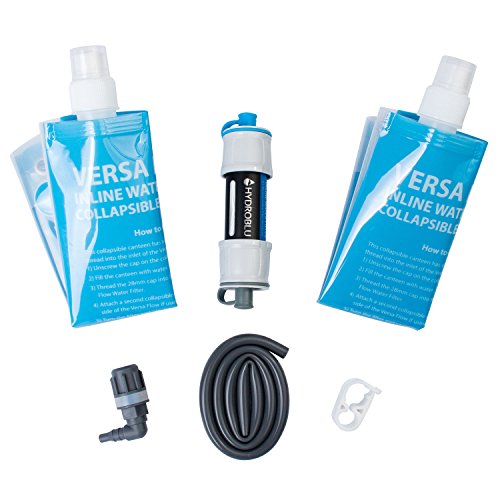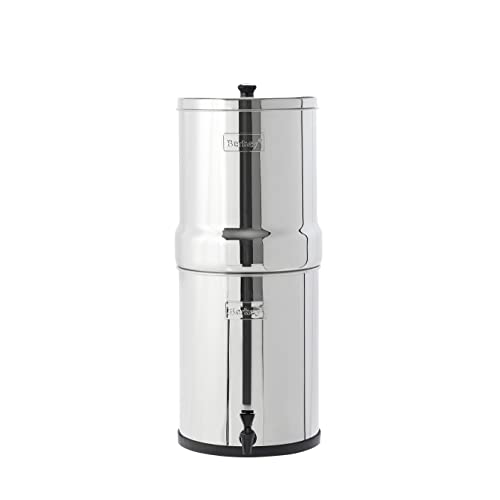SHTFPreparedness may collect a share of sales or other compensation from the links on this page.
Even now, with no immediate disasters on the horizon, water is the most valuable resource on Earth, and when the SHTF, there’s a good chance that clean H2O will be much harder to come by.
Food will likely also be quite scarce in an emergency situation, but it’s thought that a healthy adult could survive up to 2 months without eating, but no matter how healthy you are, you’ll only make it around 3 days without water.
What you need to guarantee survival when disaster strikes is a quality emergency water filter. The market can be a little tricky to navigate, but this article will be your guiding light.
So, let’s field the key question straight away… Which emergency water filter is right for you and any possible future emergencies? Well, I’m afraid there is no one-shoe-fits-all answer to this query, as the perfect filter for you will be determined by your own personal needs.
Having said that, there are three, basic, universal features to consider.
- Your water filter should be able to work with your available water source — What do you imagine you’ll be working with in an emergency? Will you have a supply of stored water, or will you be using a natural water source, such as a stream or river? Whatever your plans are, your water filter needs to be up to the task of filtering out any harmful contaminants.
- Your water filter should have suitable dimensions for the intended application — If you’re looking for something portable, it’s no use investing in something large and heavy like the Big Berkey filter. Conversely, if you’re looking for a static filter that can support your entire family, the HydroBlu Go Flow Gravity isn’t going to be of much use.
- Your water filter should have a user-friendly design — During a sudden calamity, you may not have days to thumb through a user manual, yet making a mistake could lead to the consumption of contaminated water, so it’s important that a filter has an intuitive design.
Okay, with the basics of your search for clean water covered, let’s discuss why water filtration is essential.
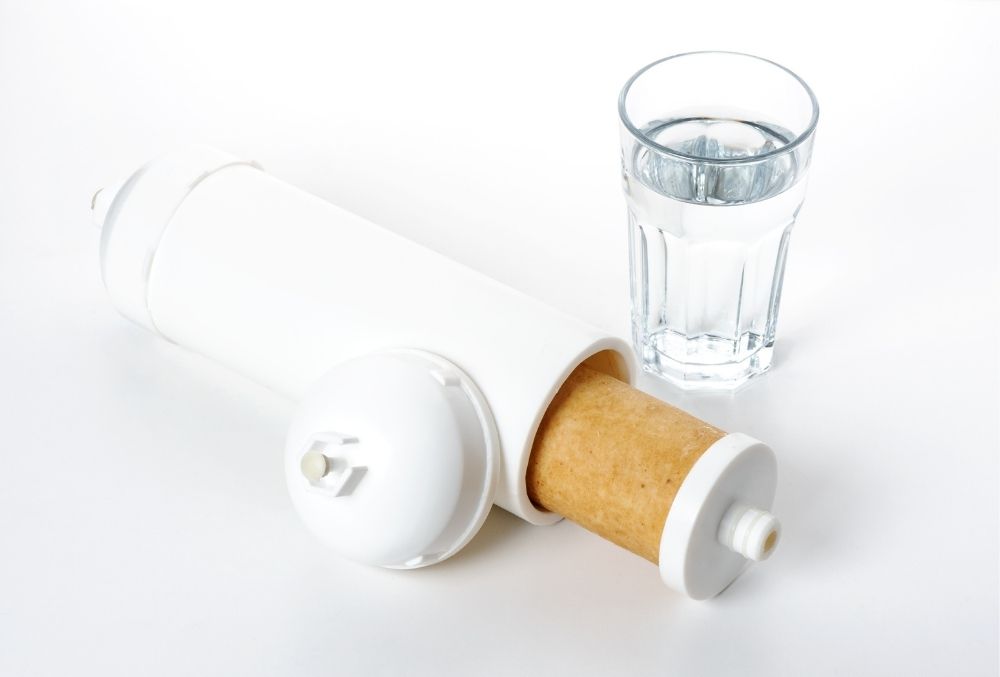
How Can My Water Supply Be Dangerous?
All manner of nasty stuff can find its way into our water. In fact, in the Middle Ages, water was so filthy that beer was often used as a substitute, but, as tempting as a frosty cold one may be in the event of a disaster, it’s essential to get your H2O supply in drinking condition!
To do this, you must be able to remove two main categories of contaminants…
The Biological Contaminants In Water
Biological contaminant is the term given to any form of microbial organisms living in our water. These include bacteria, parasites, protozoans, and viruses.
What Are Protozoa?
Protozoa are a class of single-celled microorganisms, including cryptosporidium and giardia parasites, and though they may be “micro”, they’re the largest of the biological contaminants found in water.
These big-little things sometimes have a protective outer shell, which protects them from disinfectants such as iodine and chlorine, but, thankfully, their sheer size makes them relatively easy to filter out of a water supply.
What Are Bacteria?
Bacteria are slightly smaller than protozoa, but they can be just as, if not more, problematic. Some common examples of bacteria in water include E. coli, campylobacter, salmonella, and even cholera.
Needless to say, they can make you very sick, which could mean life or death in an emergency situation, but the good news is that they’re not too small to slip through the cracks of a quality water filter.
What Are Viruses?
Viruses, on the other hand, are so dang tiny (Sometimes less than a single micron) that they’ll mosey on through almost any water filter, which means we have to get a little creative to eliminate them.
Common waterborne viruses include Norwalk virus, poliovirus, Hepatitis (both A and E), echovirus, and rotavirus, and every last one of them can make you and your cohabitants incredibly ill. In severe cases, some may even be fatal.
The Chemical Contaminants In Water
The important thing to note about chemical contaminants is that they’re not living organisms, which means they cannot be killed by means of disinfection. So, the only way to get rid of these nasty little invaders is to physically weed them out with sufficient filtration systems.
There are far too many forms of chemical contaminant to address individually in this little segment, but, to give you the gist, they include pesticides, heavy metals, salts, and any other chemical that shouldn’t be there.
Chemical contamination is a particular worry in the event of nuclear fallout, as the dissolved radioactive compounds and elements may settle in our water supply.
Much like any other chemical contaminant, these viscous pollutants cannot be removed by way of disinfection or distillation. Therefore, our only way of evicting them is through filtration and settling.
What Is Water Purification?
Simply put, water purification is the cleansing of contaminated water via three steps: clarification, disinfection, and filtration.
Do You Always Need To Follow All Three Steps Of Water Purification?
You don’t always have to treat your water with all three purifying techniques. It all comes down to the source and possible contaminants.
For instance, if you’re drawing your water from a compromised municipal source, clarification isn’t necessary as the water has been pre-clarified, but you will still need to disinfect it by boiling to destroy any residual pathogens.
What Is Water Clarification?
You can think of water clarification as macroscopic filtration. It’s a process of removing all the suspended particulate matter that can be seen with the naked eye. These pollutants might include leaves, dirt, and any other insoluble matter floating around in our H2O.
If necessary, clarification should always be the first step of your water purification protocol, otherwise, biological contaminants may avoid deactivation by “hiding” within the solid matter.
Clarification is achieved via passing water through paper towels, coffee filters, fine-woven cloths… anything that lets the moisture pass through but stops the solids in their tracks.
In the great outdoors, clarification can occur naturally as water is sifted through sand and other permeable mediums.
What Is Water Disinfection?
Once your water is clear of visible contaminants, disinfection should be your second port of call. Disinfection serves one purpose in two ways. The purpose is to neutralize biological contaminants, and it achieves this either by deactivating them or killing them outright.
There are a number of methods you can use to kill off harmful biological pathogens in water, including boiling, pasteurization, chlorination, and distillation, and it’s a good job, too, as you may not be able to destroy all biological contaminants in one fell swoop.
What Is Water Filtration?
Water filtration is the microscopic variant of clarification — now that the larger particulate matter is long gone, you can focus on the tiny stuff! Using a water filtration system, you can remove most chemical pollutants and any surviving biological contaminants, making the water both safer and more pleasant tasting.
There’s a reason why filtration is considered the “headlining act” of the purification process — if you want your filters to last a while, you’ll need to get your water as clean as possible before passing them through the system.
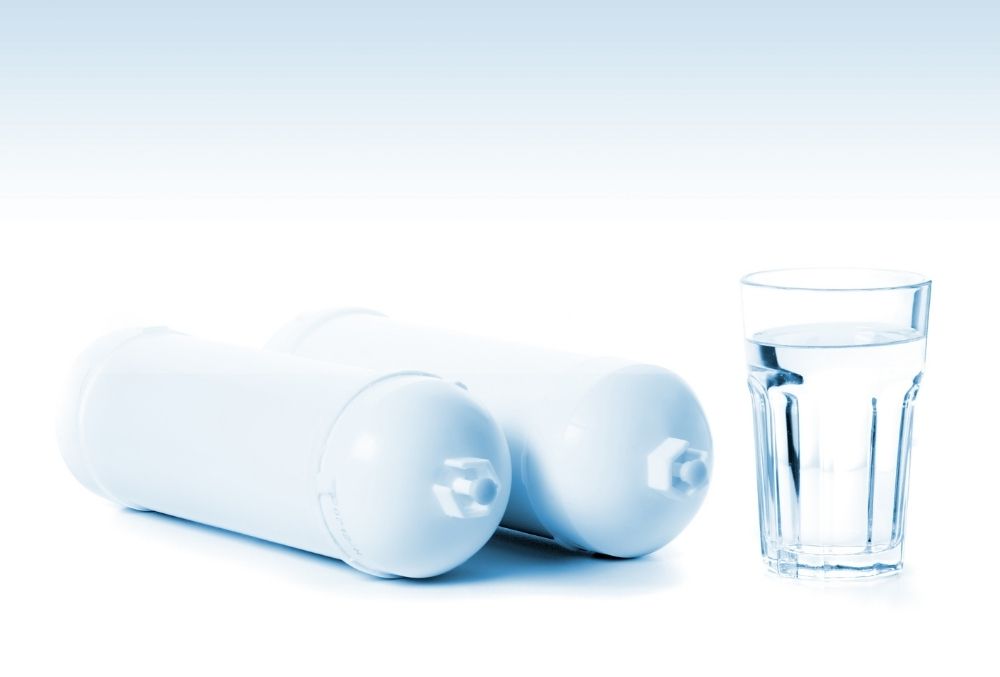
Filter Micron Ratings: Just What The Heck Are They?
Micron ratings refer to the distance between pieces of filtration media. For example, if you picture a wave lapping the shoreline and the seawater sinking into the sand, the micron rating would be a measurement of the gaps between the grains of sand.
In other words, it determines the size of the pollutants that can be weeded out when water passes through something. The smaller the rating, the smaller the particles a filter can separate from your water.
As helpful as micron ratings can be, there are a couple of things you need to be wary of when shopping around for a filter. Firstly, manufacturers may only provide the “nominal” micron rating, which is a measure of the average pore size, not the exact pore size — some will be smaller and some larger.
You may also run into something known as “absolute” pore size, which is a measurement of maximum pore size. No pores will be larger than this rating, but many may be smaller.
Understanding these terms, you’ll be able to determine the efficacy of a filter, and the kinds of contaminants it’s capable of removing from water.
Shopping Around For An Emergency Water Filter? Here’s What You Should Know!
As I mentioned earlier, the world of emergency water filters is a confusing one, to say the least, and this is exacerbated by the fact that there’s so much at stake. It may sound melodramatic, but hypothetically, choosing the right one could be the difference between life and death. Let’s take a look at a few initial considerations.
- What will be the purpose of your water filter? For example, will it be primed and ready for an evacuation, or is it to help clean up your household water supply and stay put?
- How much water will you be filtering? Will you be filtering for a full household or just yourself? Bigger isn’t always better.
- Have you thought about flow rate? Flow rate can fluctuate significantly from filter to filter — we’re talking a gallon an hour compared to a gallon a minute.
- Will you need to take your filter on the road with you? If you plan on leaving the house for an extended period of time, you’ll need something portable.
- Who in your household will have to learn to use it? You can’t be in charge of water purification duties all the time. You may need a helping hand from a child or perhaps a grandparent.
- Budget — Emergency water filters have a wide range of prices… What can you afford?
- Quality — We all love a good bargain, but saving a few pennies on a so-so filter isn’t a good idea.
This is by no means a comprehensive list, rather a few thoughts to get the juices flowing. You also need to consider the various types of water filters, which I’ll discuss in detail below.
Gravity Filters: What Are They?
Gravity water filters are exactly what they sound like. You pour water into a top section, gravity pulls it down through the filtration media, then you can access the cleaned-up H2O via a spigot near the base of the unit.
These filters are usually quite large and immobile, but they produce sizable quantities of drinkable water, so they’re perfect as countertop units for everyday use around the home. Having said that, there are plenty of portable gravity filters out there, too.
Now let’s take a look at the leading gravity filter manufacturers and their key products.
AquaRain And Their Natural Water Filter
Crafted from stainless steel, AquaRain’s Natural Water Filter can certainly roll with the punches, which is exactly what you need during and after a disaster event. It boasts three micro-pore ceramic filters, each containing self-sterilizing metallic silver and granulated activated carbon filtration media.
While it’s not rated to remove viral pollutants, it is capable of ousting most harmful contaminants without dragging any of the natural minerals and electrolytes from the water.
You can clean the filters up to 200 times, which equates to the passage of roughly 10,000 gallons of water. Capacity-wise, you’re looking at 3 gallons, which is a day’s drinking water for 6 people, and it’s capable of producing 1 of those 3 gallons every hour.
Berkey And Their Range Of Gravity Filters
Berkey is an industry leader and one of my favorite water filter manufacturers. They produce a range of differently-sized, incredibly high-quality gravity filters.
Berkey water filters are user-friendly, they look fantastic on a countertop, and their 3000-gallon Black Berkey filters are rated to remove 99.9999% of viral contaminants — that’s nothing to shrug at!
The Travel Berkey Water Filter is their smallest gravity-based option. It has a 1.5-gallon capacity, it’s crafted from commercial-grade stainless steel, and its two filters have a flow rate of 2.75 gallons per hour.
Next in line is the Big Berkey, a 2.25-gallon gravity filter suitable for use by 2–4 people. It arrives with two filters but has space for an additional two, which would boost its output to 7 gallons per hour.
Then we have the Royal Berkey, a 3.25-gallon filter that can support 6 people. Much like its little “Big” sibling, it arrives with two filters, but has room for another two, and it can produce 8 gallons of clean water per hour.
Last but not least, there’s the Crown Berkey, a 6-gallon monster of a filter capable of supporting 10+ people. It arrives with two filters but takes 8 if you have them spare, amounting to a mammoth output of 26 gallons of fully drinkable water per hour.
Measuring 11 inches width-ways, and 31 inches tall, it’s pretty massive, but this is the sort of unit you’ll need to support a large household.
I’ve got one last honorable Berkey mention… the highly portable Berkey Go Kit. This diminutive dynamo has a 1-quart capacity, which is enough to support 2 people on the go.
It has a single Black Berkey filter and can produce 1-gallon of purified water per hour. The kit also includes a BPA-free Berkey Sport Bottle for easy slurpin’ when you’re on the road.
Katadyn And Their Camp Filter
As the name suggests, this is a portable water filter designed for camping. It has just over a 1.5-gallon capacity, features a single filtration element rated for 0.3 microns, and produces a quart of water per minute.
This product is undeniably fantastic, but the filter isn’t robust enough to tackle viral pollutants, so all water will need to be treated before passing through the Camp.
MSR And Their MSR Trail Base Water Filter System
This is another portable system to help an individual survive a stint exposed to the elements.
It has a capacity just shy of 1-gallon, processes a liter of water per minute, and the hollow fiber filter is rated to remove all particulate solids, bacteria (99.9999%), and protozoa (99.9%). You will, however, have to pre-treat water to eliminate viral pollutants.
Platypus and Their GravityWorks Water Filter
Platypus is another top contender in the emergency water filtration industry. Their GravityWorks system is a highly portable unit with a 0.879-gallon capacity, and a hollow fiber element capable of removing almost all bacteria and protozoa. The filter has a flow rate of 1.75 liters per minute and has a service life of 1500 gallons.
Pump Filters: What Are They?
If a water filtration system requires you to manually pump the water through the filter media, then it’s classed as a pump filter. Much like gravity filters, pump filters can be purchased in a variety of shapes and sizes.
Some are suitable for individuals, while other larger units are designed to provide for groups. I recommend checking out the following…
Katadyn Hiker Pro
The Hiker Pro is a portable, 11oz unit kitted out with glass fiber and activated carbon media, amounting to a 0.2-micron rating. It’s capable of removing most bacteria and protozoa from water sourced in the wild.
Highly durable, it’s capable of weathering the rigors of a trip to the backcountry, but you will need to treat water to remove viral contaminants before filtration rather than simply tapping a drink from the nearest river.
Katadyn Pocket Water Filter
Made from stainless steel and aluminum, the Pocket is one of the more robust portable pump filters on the market, so it’s a no-brainer for adventurous types that often go on solo scouting missions into the wild.
In fact, Katadyn has so much faith in their creation, that it arrives with a 20-year warranty!
Featuring a silver-impregnated ceramic filter with a 0.2-micron rating, you can rely on the Pocket to whittle biological pollutants down to an absolute minimum.
The filter has a 13,000-gallon service life, so if you keep it clean, you may not have to replace it for years.
MSR MiniWorks EX Microfilter Water Filter
The MiniWorks EX is a fantastic portable filtration device with a hyperefficient filter composed of both carbon and ceramic, capable of producing a liter of purified water per minute. With proper care, a single MiniWorks filter can pass 2000 liters of water.
MSR Guardian Water Purifier Pump Filter
The MSR Guardian is a military-grade pump filter designed to keep you hydrated in the most extreme environments and circumstances.
Boasting an insanely high 2.5-liter per minute flow rate, rugged construction, a self-cleaning pump, and medical-grade filtration fibers capable of removing viral, bacterial, and protozoan pollutants, this thing is impressive on every level!
Putting the icing on the preparedness cake, each high-tech Guardian filter cartridge is rated to clean up to 10,000 liters of water.
HydroBlu Jerry Can Pump Filters
These charming Jerry can-style filters utilize a combination of hollow fiber and carbon filter technologies to eliminate both biological and chemical contaminants. The can has a 4-gallon capacity, which is a good size for a family camping expedition, and it only weighs 4.7lbs, so it’s not going to throw your back out when you’re searching for a pitch.
There are currently two HydroBlu Jerry Can options to consider…
HydroBlu Pressurized Jerry Can Pump Filter (Standard Pack)
The standard pack comes with the pressurized Jerry can pump with a 4-gallon capacity, and a 10,000 gallon, 0.1-micron, hollow fiber filter with integrated carbon media for removing chemical contaminants.
It’s an amazing product, and I highly recommend it, but bear in mind that, as strong as the filter is, it’s not rated to remove viral pollutants. For that kind of filtration power, you’ll need HydroBlu’s second offering.
HydroBlue Pressurized Jerry Can Pump Filter (Virus Free Package)
The Virus Free package comes with all the incredible stuff you get in the standard package, but you’ll notice a little extra in the box in the way of a 0.02-micron hollow fiber filter for stopping waterborne viruses in their tracks.
The Virus Free package is only marginally more expensive, and don’t worry if you already have the Standard package, as the filter expansion can be purchased separately.
Personally, I’d recommend forking out a few extra bucks for the virus protection, as the extra peace of mind it brings is well worth the premium.
This is the ultimate short family vacay water filter. When I’m headed out for a weekend in the woods with my people, this is the filter I bring. It’s easy for the kids to use, and it’s robust enough to rough a few nights in the wild. It’s also my go-to evac filter!
Suction Filters: What Are They?
Suction filters are straw-like devices used to draw water directly from a contaminated water source. For example, if you were near a river, you could lie on the bank, insert your suction filter, and take a good old sip.
Due to the proximity of your face to the contaminated liquid and the fact that the filtration happens in real-time as you drink, I’ve always been a little warier of suction filters than the types we’ve already discussed.
That said, there are some fantastic suction filters out there, and their portability makes them a great addition to a hiking kit. Some of my personal favorites include…
HydroBlu Sidekick 3-Stage Straw Water Filter
Using a pre-filter membrane, activated carbon, and a 0.1-micron hollow fiber filter, the Sidekick is primed and ready to remove heavy metals, protozoa, bacteria, and chemical pollutants; however, viral villains are a touch too small to arrest.
Weighing a minuscule 1oz, this 6” filter makes a perfect addition to a BOB (Bug Out Bag), or even just a hiking arsenal, and, as a bonus, both the unit and replacement filters are incredibly affordable — who says survival has to suck your wallet dry?
LifeStraw Personal Water Filter
This little pocket rocket is one of the most popular water filters on the market, and for good reason, too. Boasting a 0.2-micron hollow fiber membrane that can process up to 260 gallons of water, it weeds out bacteria, microplastics, and protozoa, but pretreatment is required to remove viral threats.
Sawyer Products SP105 MINI Water Filtration System
This one’s a little different. Featuring a screw fixture, rather than sucking contaminated water directly from the source, you can fill your own bottle or hydration pouch, attach SP105 MINI, and use it as an interim filtration device.
The 0.1-micron filtration media protects against 99.99999% of bacteria and 99.9999% of protozoa, and, amazingly, with proper maintenance, it’s rated to filter up to 100,000 gallons of water.
Of course, you’ll need to treat any water to remove viral contaminants before drinking them through this filter straw, but I still consider these essential BOB and evacuation devices. I keep two for each of us in our mobile emergency preparedness kit.
Water Filter Bottles: What Are They?
Water filter bottles combine the straw mechanism of suction filtration systems with an integrated reservoir, so you can drink cleaner water when you’re out and about.
The quality of the filtration media varies from bottle to bottle, but they’re all highly portable, perfect for throwing in your suitcase or backpack, and they make a great addition to any emergency kit. Here are some of the best in the biz…
Sawyer SP140 Personal Water Bottle Filter
The SP140 from industry stalwarts Sawyer features a 0.1 micron, hollow fiber, inline filter rated to separate all bacteria and protozoa from your drinking water. To use it, simply fill the bottle then slurp the water through the integrated straw.
What blows my mind about this product is that Sawyer claims it’s good for cleaning up a million gallons of water, which is roughly 30 times the amount a human will drink over the course of their entire life. If that’s not value for money, I don’t know what is.
GRAYL GeoPress Water Purifier Bottle
Granted, the GeoPress is a little expensive for a bottle filter, but it more than earns its price tag. Not only does this 24oz capsule and filter remove 99.9% of protozoal and 99.9999% bacterial content from your water, but 99.99% of viruses, too!
The filter doesn’t last quite as long as some of the other more affordable bottles on the market, but being that it’s apprehending so many pollutants, it’s only natural that it clogs up quicker than the competition. Proper maintenance and pretreating water will help to prolong the service life of the filter.
Berkey Sport Water Filter Bottle
We’re back with Berkey to celebrate this fantastic 22oz bottle with an ionic adsorption micron filtration system that will remove impurities from 25 gallons of heavily soiled water, or 100 gallons from a municipal source.
It’s an awesome bottle filter, but do bear in mind that it needs to be flushed out with a chlorinated substance before being put into storage. Replacement filters can be purchased here.
HydroBlu Clear Flow Water Filter
The Clear Flow’s 0.1-micron hollow fiber filter removes nearly all bacteria (99.99999%) and protozoa (99.9999%) from your drinking water, and thanks to the addition of activated carbon, it keeps heavy metals, sulfur, and discoloration at bay as well.
HydroBlu claims that a single filter will last for 1500 gallons of water (that’s a lot of slurps), but, like many bottle filters, it’s not suitable for removing viral threats.
What Is the Best Emergency Preparedness Water Filter?
As we touched upon earlier, the best emergency water filtration system for you will be determined by your needs, wants, and circumstances.
Some prefer to invest in a versatile filtration unit that does a little bit of a lot of things, while others prefer to amass multiple discrete systems, each tailor-made for a singular purpose.
I personally recommend the latter of these two options, as it’s the only way to truly prepare for an emergency, but I’ll take you through my own personal setup in just a moment.
Ultimately, only you have the insight to decide which filtration system is right for you and – if you have one – your family; however, I would like to recommend the following products that I’ve categorized in terms of budget.
Tight Budgets ($20+)
HydroBlu Versa Flow Water Filter System Package
The Versa Flow is one of the best value for money filtration packs on the market. Much like the Sawyer MINI we discussed earlier on, it can be screwed onto your bottles or hydration pack or even be used as a straw for drinking straight from the source.
It will rid your water of most of the bacteria and protozoa, but it falls short when it comes to viruses, so water will require pretreatment before filtration.
Sawyer Products SP105 MINI Water Filtration System
The MINI is more or less the same thing, but at an even lower price point, so if you’re really trying to tighten the purse strings, this is the filter for you.
GRAYL GeoPress Water Purifier Bottle
There are certainly cheaper bottle purifiers out there, but the GeoPress is the only one that neutralizes viruses as well as bacteria and protozoa, so if you’re sick of pre-treating your wild water, you can buy this and drink straight from the bottle.
Medium-Sized Budgets ($100+)
HydroBlu Pressurized Jerry Can Pump Filter
As you well know by now, this triple-filter Jerry Can system is one of my all-time favorites! But do yourself a favor, and invest in the Virus Free expansion. It still won’t break the $200 mark, and you won’t have to worry about pretreatments.
Larger Budgets ($200+)
Katadyn Pocket Water Filter
This sleek and robust pump filter is perfect for the consummate outdoors nut. It can handle the rough and tumble of challenging terrain, and the 0.2-micron filtration media is hugely effective. However, for potential viral pollutants, you’ll have to pre-treat the water.
The Berkey Bunch
If you can afford a countertop Berkey water filtration system, get one! They’re the best, trust me, and they ensure all the water you consume in your home is completely clear of contaminants.
The Travel Berkey is the smallest I’d go for an in-house system. It has two filters, a 1.5-gallon capacity, and can support 1–3 people.
The Big Berkey is next in line. It has a 2.25-gallon capacity that can support up to 4 people.
No products found.
Then we have the Royal Berkey, a 3.25-gallon gravity filter that can keep up to 6 people hydrated day in, day out.
The Imperial Berkey offers up 4.5 gallons of spotless water, which is enough for 10 people to wet their whistles. There’s also the Crown Berkey (the biggest Berkey of all), but that’s moving into unnecessary territory for most family units.
What Water Filters Does My Family Have in Place?
Most would say that I’ve gone a little overboard with my water filtration setup, as there are quite a few stationed in various parts of my home, but I don’t think there’s really such a thing as putting too much emphasis on clean drinking water.
At the core of our water-based emergency preparedness network, we have 2 Berkey gravity filters, the Travel, and the Royal. They have the capacity to support my entire family, so it always gives me an immense sense of wellbeing when I see them there on my kitchen counter.
That said, if we see a few new additions to the family at some point in the future, we’ll likely bring home an Imperial as well.
We upgraded to the Berkey filters from the AquaRain filter, which is an amazing unit, but the filters aren’t capable of removing viral contaminants. We still have it as a back-up, though.
Another staple of our safe water network is, of course, the HydroBlue Pressurized Jerry Can with the Virus Free expansion, the ideal filter for family road and camping trips. Its reliability and portability have also earned it a place in my evac pack.
And finally, have quite a large variety of different bottle filters, some for everyday use, and some set aside in emergency packs, just in case.
Final Thoughts — Which Emergency Water Filter Should You Choose?
We’ve covered a hell of a lot of ground here today, and, to be honest, we could have covered a whole lot more, as there are plenty of awesome filters out there that we didn’t discuss, filters that might be just what you’re looking for.
Still, we’ve addressed all the basics, so now you’re fully equipped to buy an emergency water filter (or three), with confidence.
The two main questions you should be asking yourself are…
- What would my filtration needs be in the event of an emergency?
- How many people will be relying on the water filter?
Take a moment to think it all through and visualize possible emergency scenarios.
Let your needs guide you to the right products. If you can’t quite afford the perfect filter for your circumstances, invest in a temporary solution that will ensure you have safe water to drink if calamity strikes tomorrow.
Hopefully, it won’t, and you can build your water filtration network from there over time.




